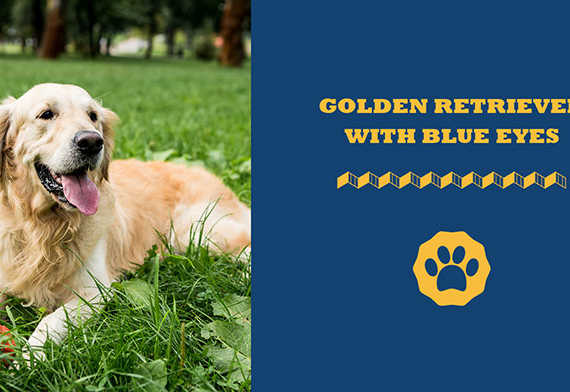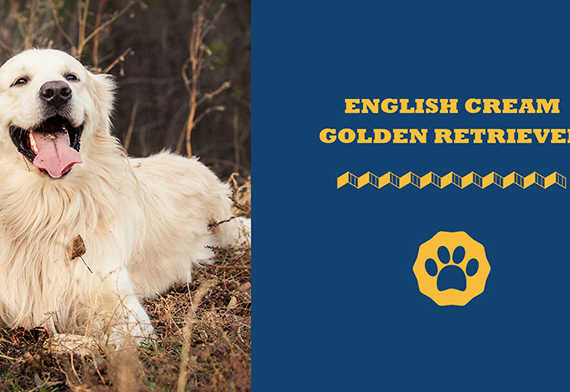Updated: August 13th, 2022
This article contains affiliate links. Read the full disclosure here.
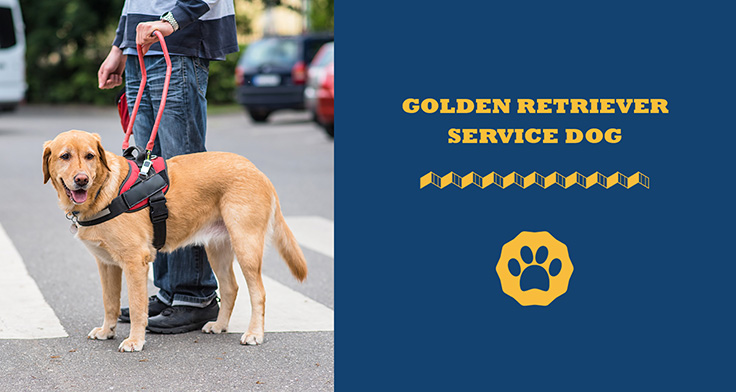
Dogs have always shared a special, unbreakable bond with human beings. For people from all walks of life, owning a dog can make a huge difference in how you go about your day-to-day routine. Owning a dog, especially a service dog like a golden retriever, is especially important to those who are disabled, chronically ill, or have other special needs.
Right from the name, you can learn a bit about this wonderful breed and why these dogs make such great service animals. Golden retrievers were originally bred to gently retrieve a kill after a hunt without damaging the animal. A few years down the line, goldens have proven to be so much more than mere hunting companions.
Thanks to their high level of intelligence, friendliness, and people-pleasing nature, golden retriever service dogs are perfect for people with special needs and disabilities. They can carry out a variety of tasks that prove difficult throughout your daily routine.
Keep in mind, though, that it takes a lot of time, planning, commitment, and professional observation to successfully train a service dog.
Adopting a fully trained service dog is no cheap endeavor, either. Fortunately, owning a golden retriever is already half the challenge! Let me walk you through the step-by-step process of how to make sure your furry friend is service-ready.
Step 1: Prepare Your Dog For Training
Before you begin training your golden retriever, here are a couple of things you will want to figure out first as far as the logistics of their training. I’ve detailed each of them below.
Check Your Dog’s Temperament
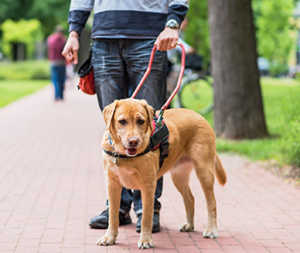
Before you put your golden retriever on the training stand, you’ll first need to observe its temperament. It’s advisable to begin training when your golden is still a pup. However, adult golden retrievers are equally quick learners.
Naturally, these friendly dogs are calm yet confident. This valuable trait makes golden retrievers a suitable candidate for emotional support and service dogs. Note that not all breeds have what it takes to handle the special duties of a service dog.
You don’t want a dog that’s too timid or too aggressive, especially towards strangers. An easy-going temperament ensures your dog can comfortably carry out special tasks in any environment without shying away or being easily distracted.
You can learn more about this breed by reading Golden retriever training books.
What Do I Need For Training?
Once you’ve determined your dog has the right temperament to become a service animal, you’ll next need the right items to complete your training program.
Dogs respond well to treats! A tasty treat is a great way to reinforce positive behavior and motivate faster progress. Also, don’t forget toys. Golden retrievers are packed with energy and enjoy having a toy (or a few of them) to chew on and paw around. Playful activity enhances your dog’s cognitive abilities and strengthens your bond.
Next, be sure to get a nice, strong leash with a soft, padded collar. A leash will help coordinate your dog’s movements during training, walking, or exercising outdoors. Include a name tag for easier identification.
Remember, service dogs in training have a special responsibility and should stand out. You can strap a comfortable, clearly labeled vest around your golden retriever to notify the public of your dog’s status.
All that’s left is a comprehensive training schedule that should at least cover half a year or more. Consistency is key in maintaining high levels of performance from your service dog.
Come Up With A Reward System
All golden retrievers are unique. What makes your dog leap for joy and wag its tail endlessly? Finding out what your dog loves is key in using it as an effective reward system.
Goldens are very perceptive and will soon realize a reward will only be presented if they perform an intended task. Not only will this speed up your dog’s progress, but it’s also a good way to make sure your dog is always obedient, with or without a reward. Learn what kinds of treats and toys your dog loves most for best results.
Outline The Level Of Obedience For Specific Tasks
While your furry friend is more than happy to receive a reward, fully trained golden retriever service dogs need a high level of obedience. An obedient dog is willing to follow your instructions, whether simple or complex, and be able to perform necessary tasks flawlessly without fail.
For instance, you can test your dog’s level of obedience in simple instructions. Does your dog sit when you instruct it to? For how long does your dog sit when you tell it to “stay?” How about other commands like “come,” “fetch,” and “leave?”
Your golden retriever emotional support dog should be able to get through such simple instructions while paying close attention to your every move. A high level of obedience is especially convenient when you need your service dog’s assistance in public places.
Step 2: Perfect Your Instruction
Once your dog has a solid grasp of all your instructions, it’s time to iron out the creases and master how you communicate with your service dog. It’s very easy for your dog to get confused if you’ve not thoroughly prepared for every scenario.
You can create different situations where you issue different instructions in quick succession.
Observe how your golden retriever performs under pressure. You’ll be in a better position to gauge just how fast and composed your dog reacts when you give out an instruction. Perfecting your level of communication is a proactive way of working out any problems and makes your routine second nature.
Step 3: Put Everything Into Practice
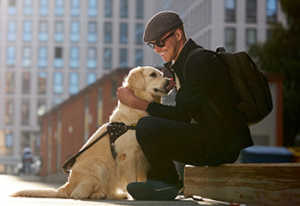
It’s one thing to train with your golden retriever under controlled conditions. However, things don’t always go as planned in the real world. Take time to practice with your dog in a variety of scenarios. For example, take a walk or go for a morning run with your pup.
Pay close attention to how your service dog reacts in certain scenarios and think about what you can do to make things easier to understand for them. Is your leash effective in coordinating your dog’s movements? Also, try taking a route with moderate traffic. How does your dog respond to fast-moving cars and people walking by?
Exposing your retriever to such environments is beneficial in smoothly transitioning from a controlled environment to how things actually work in the real world.
Above all else, loosen up your training program and keep it as fun as possible. Dogs are only serious when they need to be! Most of the time, your golden retriever is a ball of sunshine that’s ready to light up your world and everyone in it.
A professional approach would be to balance both structured and unstructured activities in your training schedule.
Have an effective reward system put in place. Goldies love a challenge and will push through any hurdles just to get that tasty treat and make you proud.
It’s just as important to include plenty of rest time as well. Have your dog sit by you as you read a book, make a cup of coffee, or watch your favorite TV show. This will reinforce your bond with them.
Step 4: Start Defining Your Specific Needs
It’s safe to say you’re now past the beginner’s training ground. It’s now time to grab your dog’s undivided attention and focus on your actual needs.
Golden retrievers have a couple of unique traits beneath their paws, such as their easygoing temperaments and people-pleasing natures. These traits make them the perfect service dogs for a variety of settings, such as:
- Guide Dogs – Guide dogs are an indispensable accessory if you are visually or hearing impaired. Are you using crutches or need help pulling your wheelchair? If so, you can definitely benefit a lot from a service dog.
- Therapy Dogs – Therapy treatment has come a long way. Children with special needs have shown a lot of improvement just by being near a certified therapy dog! Patients with certain mental health disorders also progress a lot more when a therapy dog is included in treatment plans.
- Emotional Support Dogs – Note that service dogs offering emotional support don’t necessarily cover a specific need or have any professional training. Emotional support dogs usually visit healthcare facilities that need a boost in morale and spirits, such as hospitals, retirement homes, psychiatric facilities, and funeral homes.
- Assistance Dogs – Golden retrievers make excellent general assistance dogs, as they are always willing to offer you a helping paw in specific tasks such as opening doors, flipping a switch on and off, or looking for help when you’re injured and can’t move.
Be sure to write down a detailed list of the kinds of things you would love your golden retriever service dog to be great at. This will help you keep track of what tasks your dog has been trained to do and what tasks they still need more training in order to complete reliably and consistently.
Add any other task that you can train on later as you think of them. Go through each instruction one after the other. Take it one day at a time and focus on mastering previous instructions when progress is slow.
It’s hard work trying to cover everything, but it’s good to keep close tabs on your progress and refine your training program even more.
Expert Tips For Training Your Service Dog
Now that you know what you’ll need to do to get your golden retriever service-ready, here are some key tips to keep in mind throughout the entire process.
Practice As Often As You Can
Practice always makes perfect. The more you go through your training schedule and reward your dog’s progress, the faster you’ll become an inseparable pair that can take on any challenge!
Of course, you also don’t want to end up burning your dog out with constant or excessive training. Allow your pup to rest from time to time, and offer them plenty of treats as positive reinforcement.
Get Your Dog Used To Public Areas
Any publicly accessed area is the ultimate testing ground for your golden retriever emotional support or service dog. Does your dog give you its undivided attention despite all the distractions and noises around? Slowly work your way up from less populated areas like parks to more busy areas.
That said, please note that fully trained service dogs should have certification from respective authorities. While it’s not mandatory for most settings, having proper certification shows your dog is legally certified to cater for you in both personal and public spaces.
Frequently Asked Questions About Golden Retriever Assistance Dogs
How do I know my golden retriever is a suitable candidate for service training?
All dog breeds portray a certain level of intelligence and the ability to learn both simple and complex tasks.
However, not all breeds are suitable candidates to become service or emotional support dogs. Thankfully, though, most (but not all) golden retrievers tend to do very well in these positions. From a young age, your golden retriever should have a good temperament, have a high level of obedience, and show a willingness to follow the most basic instructions.
What area of service does a golden retriever excel in most?
Considering the many unique traits golden retrievers have, they have a lot of potential to serve even before you put a formal training program in place.
From being guide dogs to offering assistance, therapy, and emotional support, golden retrievers can generally switch between any of these roles effortlessly. This automatically makes them a top-tier breed that performs exceptionally well under any area of service.
Dusting Off My Paws
At the end of the day, you don’t have to be a professional dog trainer to get your golden retriever service-ready. With a comprehensive training plan based on the above guidelines, you are good to go. Just keep the following tips in mind moving forward:
- Start training early when your golden retriever is still a pup (6 to 12 months old).
- Stick to the basics and use them as a solid foundation for your more complex tasks.
- Remember, training your service dog will be a mutual learning experience. Take time to enjoy each level of progress. For example, you can draw a progress chart to record your dog’s reward points or even add stars to your dog’s training vest for a final touch!
Best of luck as you embark on training your golden retriever to be a service dog!

